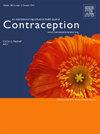POSTPARTUM PERMANENT CONTRACEPTION ACCESS FOR NONCITIZENS AFTER EXPANDING MEDICAID
IF 2.3
2区 医学
Q1 OBSTETRICS & GYNECOLOGY
引用次数: 0
Abstract
Objectives
We aimed to determine if expansion of Medicaid to noncitizen pregnant patients through the Maryland Healthy Babies Equity Act (HBEA) impacted fulfillment of postpartum permanent contraception (PC).
Methods
We conducted a retrospective, observational, interrupted time series analysis of patients who underwent postpartum PC within the Johns Hopkins Health System from January 2019 to September 2024. We included all deliveries at Johns Hopkins Hospital, Johns Hopkins Bayview Medical Center, and Howard County General Hospital. Maternal demographics, delivery information, neonatal outcome, and postpartum contraception methods were extracted from EPIC. Citizenship status was confirmed via manual chart review. We compared postpartum PC rates before and after HBEA implementation for citizens and noncitizens. Mixed effects logistic regression was used to compare postpartum PC rates before and after HBEA implementation, stratified by citizenship.
Results
There were 35,996 deliveries among 30,007 individuals at Johns Hopkins hospitals during the study period. Individuals’ mean (SD) age was 30.9 years (5.7). Some 25,652 (85.5%) were citizens, and 4,355 (14.5%) were noncitizens. Among noncitizens, postpartum PC rates increased from 8.5% (332/3,925) pre-HBEA to 12.5% (134/10,755) post-HBEA. Among citizens, rates remained stable from 5.4% (1,346/25,003) pre-HBEA to 5.3% (318/5,993) post-HBEA. The increase in postpartum PC rate from pre to post-HBEA among noncitizens was significantly greater than the change in postpartum PC rate among citizens (p<0.001).
Conclusions
Expansion of Emergency Medicaid under the HBEA to include postpartum care was associated with a significant increase in postpartum PC among noncitizens. Such policy changes help overcome systemic barriers to postpartum care for low-income, noncitizen individuals.
扩大医疗补助后,非公民获得产后永久避孕
目的:我们旨在确定通过马里兰州健康婴儿公平法案(HBEA)将医疗补助扩大到非公民孕妇是否影响了产后永久避孕(PC)的实现。方法对2019年1月至2024年9月在约翰霍普金斯卫生系统接受产后PC治疗的患者进行回顾性、观察性、中断时间序列分析。我们纳入了约翰霍普金斯医院、约翰霍普金斯湾景医疗中心和霍华德县总医院的所有分娩。从EPIC中提取产妇人口统计资料、分娩信息、新生儿结局和产后避孕方法。通过手工图表审查确认公民身份。我们比较了实施HBEA前后公民和非公民的产后PC率。采用混合效应logistic回归比较实施HBEA前后的产后PC率,按国籍分层。结果在研究期间,在约翰霍普金斯医院的30007人中有35996人分娩。个体平均(SD)年龄为30.9岁(5.7岁)。25652人(85.5%)是公民,4355人(14.5%)是非公民。在非公民中,产后PC率从孕前的8.5%(332/3,925)上升到孕后的12.5%(134/10,755)。在公民中,发病率保持稳定,从hbea前的5.4%(1,346/25,003)到hbea后的5.3%(318/5,993)。非市民产后PC率从孕前到孕后的增加显著大于市民产后PC率的变化(p<0.001)。结论:在HBEA下扩大紧急医疗补助以包括产后护理与非公民产后PC的显著增加有关。这些政策变化有助于克服低收入、非公民个人产后护理的系统性障碍。
本文章由计算机程序翻译,如有差异,请以英文原文为准。
求助全文
约1分钟内获得全文
求助全文
来源期刊

Contraception
医学-妇产科学
CiteScore
4.70
自引率
17.20%
发文量
211
审稿时长
69 days
期刊介绍:
Contraception has an open access mirror journal Contraception: X, sharing the same aims and scope, editorial team, submission system and rigorous peer review.
The journal Contraception wishes to advance reproductive health through the rapid publication of the best and most interesting new scholarship regarding contraception and related fields such as abortion. The journal welcomes manuscripts from investigators working in the laboratory, clinical and social sciences, as well as public health and health professions education.
 求助内容:
求助内容: 应助结果提醒方式:
应助结果提醒方式:


